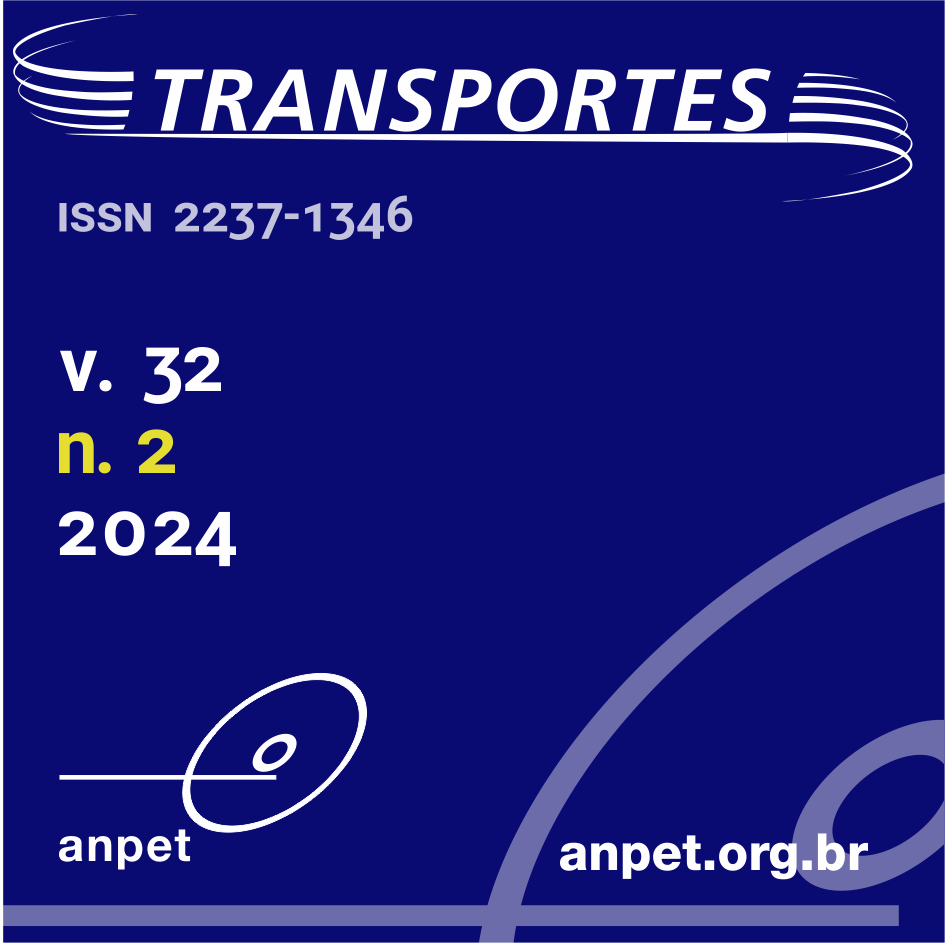Comparação entre centralidades baseadas na distância e no estresse para ranquear locais prioritários para investimentos em infraestrutura cicloviária em cidades de pequeno porte
DOI:
https://doi.org/10.58922/transportes.v32i2.2890Palavras-chave:
Bicicleta, Nível de Estresse, Centralidade, Cidades de pequeno porteResumo
A carência de diretrizes técnicas que auxiliem na definição de locais com prioridade de investimentos é uma das barreiras ao ciclismo em países emergentes, limitando a preparação de planos de mobilidade urbana mesmo quando exigidos legalmente. O objetivo deste trabalho é propor e comparar duas abordagens, com e sem considerar a percepção do estresse de ciclistas (avaliada com base no LTS, ou Level of Traffic Stress), para determinação da importância relativa de segmentos viários na rede e hierarquização de infraestruturas cicloviárias prioritárias. Um estudo de caso foi conduzido na cidade de Bariri (Brasil), para a qual foram mapeadas e ranqueadas, por ambos os critérios, as contribuições gerais de cada link da rede às rotas cicláveis identificadas. A distribuição espacial das diferenças de classificações homólogas (classificações, pelos diferentes critérios, correspondentes a um mesmo link) também foi mapeada e a autocorrelação espacial entre essas diferenças foi avaliada pelo Índice de Moran Local, permitindo elencar trechos viários de maior similaridade e dissimilaridade entre as abordagens propostas para a alocação de recursos.
Downloads
Referências
Andrade, V.; J. Rodrigues; F. Marino et al. (2016) Mobilidade por Bicicleta no Brasil (1a ed.). Rio de Janeiro: PROURB/UFRJ.
Anselin, L. (1995) Local Indicators of Spatial Association - LISA, Geographical Analysis, v. 27, n. 2, p. 93-115. DOI: 10.1111/j.1538- 4632.1995.tb00338.x. DOI: https://doi.org/10.1111/j.1538-4632.1995.tb00338.x
Anselin, L.; I. Syabri and Y. Kho (2006) GeoDa: an introduction to spatial data analysis, Geographical Analysis, v. 38, n. 1, p. 5-22. DOI: 10.1111/j.0016-7363.2005.00671.x. DOI: https://doi.org/10.1111/j.0016-7363.2005.00671.x
Arellana, J.; M. Saltarín; A.M. Larranaga et al. (2020) Developing an urban bikeability index for different types of cyclists as a tool to prioritize bicycle infrastructure investments, Transportation Research Part A, Policy and Practice, v. 139, p. 310-34. DOI: 10.1016/j.tra.2020.07.010. DOI: https://doi.org/10.1016/j.tra.2020.07.010
Austroads (2014) Cycling Aspects of Austroads Guides (2nd ed.). Sydney: Austroads Ltd..
Beura, S.K.; V.L. Manusha; H. Chellapilla et al. (2018) Defining bicycle levels of service criteria using levenberg-marquardt and self-organizing map algorithm, Transportation in Developing Economies, v. 4, n. 2, p. 11. DOI: 10.1007/s40890-018-0066-0. DOI: https://doi.org/10.1007/s40890-018-0066-0
Brasil (2007) Caderno de Referência para Elaboração de Plano de Mobilidade por Bicicleta nas Cidades. Brasília: Brazilian Bicycle Mobility Program.
Brasil (2012) Law Nr. 12.587 of January 3, 2012. Establishes the Guidelines of the National Urban Mobility Policy. Brazilian Union Official Diary, Brasília.
Brasil (2019) Pesquisa Nacional de Mobilidade Urbana 2018. Brasília. Available at: <https://www.gov.br/cidades/pt-br/assuntos/ mobilidade-urbana/Relatorio_Pemob_2018.pdf> (accessed 04/27/2024).
Broach, J.; J. Dill and J. Gliebe (2012) Where do cyclists ride? A route choice model developed with revealed preference GPS Data, Transportation Research Part A, Policy and Practice, v. 46, n. 10, p. 1730-40. DOI: 10.1016/j.tra.2012.07.005. DOI: https://doi.org/10.1016/j.tra.2012.07.005
Callister, D. and M. Lowry (2013) Tools and strategies for wide-scale bicycle level-of-service analysis, Journal of Urban Planning and Development, v. 139, n. 4, p. 250-7. DOI: 10.1061/(ASCE)UP.1943-5444.0000159. DOI: https://doi.org/10.1061/(ASCE)UP.1943-5444.0000159
Cervero, R.; S. Denman and Y. Jin (2019) Network design, built and natural environments, and bicycle commuting: evidence from british cities and towns, Transport Policy, v. 74, p. 153-64. DOI: 10.1016/j.tranpol.2018.09.007. DOI: https://doi.org/10.1016/j.tranpol.2018.09.007
Conrow, L.; E. Wentz; N. Trisalyn et al. (2018) Comparing spatial patterns of crowdsourced and conventional bicycling datasets, Applied Geography, v. 92, p. 21-30. DOI: 10.1016/j.apgeog.2018.01.009. DOI: https://doi.org/10.1016/j.apgeog.2018.01.009
Dijkstra, E.W. (1959) A note on two problems in connexion with graphs, Numerische Mathematik, v. 1, n. 1, p. 269-71. http://doi. org/10.1007/BF01386390. DOI: https://doi.org/10.1007/BF01386390
EMBRAPA (1979) Brazilian National Soil Survey and Conservation Service. In Anais da 10ª Reunião Técnica de Levantamento de Solos. Rio de Janeiro: EMBRAPA.
Ferenchak, N.N. and W.E. Marshall (2020) Validation of bicycle level of traffic stress and perceived safety for children, Transportation Research Record: Journal of the Transportation Research Board, v. 2674, n. 4, p. 397-406. DOI: 10.1177/0361198120909833. DOI: https://doi.org/10.1177/0361198120909833
Furth, P.G. (2017) Level of Traffic Stress Criteria for Road Segments Version 2.0. Available at: <https://bpb-us-w2.wpmucdn.com/ sites.northeastern.edu/dist/e/618/files/2014/05/LTS-Tables-v2-June-1.pdf> (accessed 04/27/2024).
Furth, P.G.; M.C. Mekuria and H. Nixon (2016) Network connectivity for low-stress bicycling, Transportation Research Record: Journal of the Transportation Research Board, v. 2587, n. 1, p. 41-9. DOI: 10.3141/2587-06. DOI: https://doi.org/10.3141/2587-06
GEIPOT (2001) Manual de Planejamento Cicloviário. Brasília: GEIPOT.
Google Maps (2023) Bariri-SP, Brazil. Available at: <https://www.google.com.br/maps/place/Bariri> (accessed 12/22/2021).
Guerreiro, T.C.M.; J.K. Providelo; C.S. Pitombo et al. (2018) Data-Mining, GIS and multicriteria analysis in a comprehensive method for bicycle network planning and design, International Journal of Sustainable Transportation, v. 12, n. 3, p. 179-91. DOI: 10.1080/15568318.2017.1342156. DOI: https://doi.org/10.1080/15568318.2017.1342156
Harkey, D.L.; D.W. Reinfurt; M. Knuiman et al. (1998) Development of a Bicycle Compatibility Index: A Level of Service Concept. Chapel Hill, USA: Highway Safety Research Center. DOI: http://doi.org/10.3141/1636-03. DOI: https://doi.org/10.3141/1636-03
IBGE (2012) 2010 Brazilian Demographic Census [Data set]. Available at: <https://www.ibge.gov.br/geociencias/organizacao-do-territorio/malhas-territoriais/28971-base-de-faces-de-logradouros-dobrasil.html?=&t=acesso-ao-produto> (accessed 04/16/2022).
IBGE (2022) Population Estimates. Available at: <https://cidades.ibge.gov.br/brasil/sp/bariri/panorama> (accessed 04/16/2022)
INPE (2008) TOPODATA: banco de dados geomorfométricos do Brasil [Data set]. Available at: <http://www.dsr.inpe.br/topodata/ acesso.php>(accessed 04/16/2022).
Klobucar, M.S. and J.D. Fricker (2007) Network evaluation tool to improve real and perceived bicycle safety, Transportation Research Record: Journal of the Transportation Research Board, v. 2031, n. 1, p. 25-33. DOI: 10.3141/2031-04. DOI: https://doi.org/10.3141/2031-04
Lobo, Z.; V. Andrade and J. Rodrigues (2020) Available at: <http://ta.org.br/perfil/ciclista18.pdf> (accessed 03/25/2022).
Lowry, M.; D. Callister; M. Gresham et al. (2012) Assessment of cummunitywide bikeability with bicycle level of service, Transportation Research Record: Journal of the Transportation Research Board, v. 2314, n. 1, p. 41-8. DOI: 10.3141/2314-06. DOI: https://doi.org/10.3141/2314-06
Lowry, M.; P. Furth and T. Hadden-Loh (2016) Prioritizing new bicycle facilities to improve low-stress network connectivity, Transportation Research Part A, Policy and Practice, v. 86, p. 124-40. DOI: 10.1016/j.tra.2016.02.003. DOI: https://doi.org/10.1016/j.tra.2016.02.003
McDaniel, S.; M. Lowry and M. Dixon (2014) Using origin-destination centrality to estimate directional bicycle volumes, Transportation Research Record: Journal of the Transportation Research Board, v. 2430, n. 1, p. 12-9. DOI: 10.3141/2430-02. DOI: https://doi.org/10.3141/2430-02
McNeil, N. (2011) Bikeability and the 20-Min Neighborhood: how infrastructure and destinations influence bicycle accessibility, Transportation Research Record: Journal of the Transportation Research Board, v. 2247, n. 1, p. 53-63. DOI: 10.3141/2247-07. DOI: https://doi.org/10.3141/2247-07
Mekuria, M. C.; P. G. Furth and H. Nixon (2012) Low-Stress Bicycling and Network Connectivity. San José, CA: Mineta Transportation Institute.
Melo, L.E.A. and C.A. Isler (2023) Integrating link count data for enhanced estimation of deterrence functions: a case study of short-term bicycle network interventions, Journal of Transport Geography, v. 112, p. 103711. DOI: 10.1016/j.jtrangeo.2023.103711. DOI: https://doi.org/10.1016/j.jtrangeo.2023.103711
Menghini, G.; N. Carrasco; N. Schüssler et al. (2010) Route choice of cyclists in Zurich, Transportation Research Part A, Policy and Practice, v. 44, n. 9, p. 754-65. DOI: 10.1016/j.tra.2010.07.008. DOI: https://doi.org/10.1016/j.tra.2010.07.008
Monari, M. (2022) Nível de Estresse de Ciclistas e Geoprocessamento de Dados Abertos Combinados para a Definição de Redes Cicloviárias em Cidades de Pequeno Porte. Thesis (Transportation Engineering), University of São Paulo, São Carlos.
Monari, M. and P.C.L. Segantine (2022) Cycling planning in small-sized brazilian cities based on open data geoprocessing, Revista Brasileira de Cartografia, v. 74, n. 2, p. 418-36. DOI: 10.14393/rbcv74n2-63475. DOI: https://doi.org/10.14393/rbcv74n2-63475
Morais, A.C.M.D. and E.M.D. Santos (2020) Avaliação das estruturas organizacionais dos organismos gestores da mobilidade diante da Política Nacional de Mobilidade Urbana, Urbe. Revista Brasileira de Gestão Urbana, v. 12, p. e20190232. DOI: 10.1590/2175- 3369.012.e20190232. DOI: https://doi.org/10.1590/2175-3369.012.e20190232
Moran, S.K.; W. Tsay; S. Lawrence et al. (2018) Lowering bicycle stress one link at a time: where should we invest in infrastructure, Transportation Research Record: Journal of the Transportation Research Board, v. 2672, n. 36, p. 33-41. DOI: 10.1177/0361198118783109. DOI: https://doi.org/10.1177/0361198118783109
Pucher, J. and R. Buehler (2012). City Cycling. Cambridge: MIT Press. DOI: 10.7551/mitpress/9434.001.0001. DOI: https://doi.org/10.7551/mitpress/9434.001.0001
Rodrigues, M.R.; A.N.R. Silva and I.P. Teixeira (2022) Assessing the applicability of the cyclists’ Level of Traffic Stress (LTS) classification to a medium-sized city in a developing country, Journal of Transport & Health, v. 24, p. 101321. DOI: 10.1016/j.jth.2021.101321. DOI: https://doi.org/10.1016/j.jth.2021.101321
Rybarczyk, G. and C. Wu (2010) Bicycle facility planning using gis and multi-criteria decision analysis, Applied Geography, v. 30, n. 2, p. 282-93. DOI: 10.1016/j.apgeog.2009.08.005. DOI: https://doi.org/10.1016/j.apgeog.2009.08.005
Rybarczyk, G.; A. Ozbil; E. Andresen et al. (2020) Physiological responses to urban design during bicycling: a naturalistic investigation, Transportation Research Part F: Traffic Psychology and Behaviour, v. 68, p. 79-93. DOI: 10.1016/j.trf.2019.12.001. DOI: https://doi.org/10.1016/j.trf.2019.12.001
SEMOB (2021) Bate-Papo com a CNM Orienta os Gestores na Implementação de Planos de Mobilidade Urbana. Available at: <https://www.cnm.org.br/comunicacao/noticias/bate-papo-com-a-cnm-orienta-os-gestores-na-implementacao-de-planos-de-mobilidade-urbana>. Access: December 22, 2021.
Sener, I.N.; N. Eluru and C.R. Bhat (2009) An analysis of bicycle route choice preferences in Texas, US, Transportation, v. 36, n. 5, p. 511-39. DOI: 10.1007/s11116-009-9201-4. DOI: https://doi.org/10.1007/s11116-009-9201-4
Shimbel, A. (1953) Structural parameters of communication networks, The Bulletin of Mathematical Biophysics, v. 15, n. 4, p. 501-7. DOI: 10.1007/BF02476438. DOI: https://doi.org/10.1007/BF02476438
Soares, A. and D. Guth (2018) O Brasil que Pedala: A Cultura da Bicicleta nas Cidades Pequenas (1st ed.). Rio de Janeiro: Jaguatirica.
Toole, J. (2010) Revising the AASHTO Guide for the Development of Bicycle Facilities. Available at: <https://onlinepubs.trb.org/ onlinepubs/nchrp/docs/nchrp_15-37_fr.pdf> (accessed 03/25/2022).
Transport Scotland (2010) Cycling by Design 2010. Glasgow: Transport Scotland.
TRB (2010) Highway Capacity Manual. Washington, D.C.: TRB.
Vieira, P.; J. Costeira; S. Brandão et al. (2016) SMARTcycling: assessing cyclists’ driving experience. In: 2016 IEEE Intelligent Vehicles Symposium. Gothenburg, Sweden: IEEE, p. 1321-1326. DOI: 10.1109/IVS.2016.7535561. DOI: https://doi.org/10.1109/IVS.2016.7535561
Wang, H.; M. Palm; C. Chen et al. (2016) Does bicycle network level of traffic stress (LTS) explain bicycle travel behavior? Mixed results from an Oregon case study, Journal of Transport Geography, v. 57, p. 8-18. DOI: 10.1016/j.jtrangeo.2016.08.016. DOI: https://doi.org/10.1016/j.jtrangeo.2016.08.016
Winters, M.; K. Teschke; M. Grant et al. (2010) How far out the way will we travel? Built environmental influences on route selection for bicycle and car travel, Transportation Research Record: Journal of the Transportation Research Board, v. 2190, n. 1, p. 1-10. DOI: 10.3141/2190-01. DOI: https://doi.org/10.3141/2190-01
Zeile, P.; B. Resch; M. Loidl et al. (2016) Urban emotions and cycling experience - enriching traffic planning for cyclists with human sensor data, Journal for Geographic Information Science, v. 4, n. 1, p. 204-16. DOI: 10.1553/giscience2016_01_s204. DOI: https://doi.org/10.1553/giscience2016_01_s204
Downloads
Publicado
Como Citar
Edição
Seção
Licença
Copyright (c) 2024 Marcelo Monari, Paulo Cesar Lima Segantine, Antônio Nelson Rodrigues da Silva, Murilo Ribeiro Rodrigues, Irineu da Silva

Este trabalho está licenciado sob uma licença Creative Commons Attribution 4.0 International License.
Ao submeter um manuscrito para publicação neste periódico, todos os seus autores concordam, antecipada e irrestritamente, com os seguintes termos:
- Os autores mantém os direitos autorais e concedem à Transportes o direito de primeira publicação do manuscrito, sem nenhum ônus financeiro, e abrem mão de qualquer outra remuneração pela sua publicação pela ANPET.
- Ao ser publicado pela Transportes, o manuscrito fica automaticamente licenciado sob a Licença Creative Commons CC BY 4.0. Esta licença permite o seu compartilhamento com reconhecimento da autoria e da publicação inicial neste periódico.
- Os autores têm autorização para assumir contratos adicionais separadamente, para distribuição não exclusiva da versão do trabalho publicada neste periódico (por ex.: publicar em repositório institucional ou como capítulo de livro), com reconhecimento da publicação inicial na Transportes, desde que tal contrato não implique num endosso do conteúdo do manuscrito ou do novo veículo pela ANPET.
- Os autores têm permissão e são estimulados a publicar e distribuir seu manuscrito online (por ex.: em repositórios institucionais ou na sua página pessoal) depois de concluído o processo editorial. Como a Transportes é de acesso livre, os autores são estimulados a usar links para o DOI do artigo nesses casos.
- Os autores garantem ter obtido a devida autorização dos seus empregadores para a transferência dos direitos nos termos deste acordo, caso esses empregadores possuam algum direito autoral sobre o manuscrito. Além disso, os autores assumem toda e qualquer responsabilidade sobre possíveis infrações ao direito autoral desses empregadores, isentando a ANPET e a Transportes de toda e qualquer responsabilidade neste sentido.
- Os autores assumem toda responsabilidade sobre o conteúdo do manuscrito, incluindo as devidas e necessárias autorizações para divulgação de dados coletados e resultados obtidos, isentando a ANPET e a Transportes de toda e qualquer responsabilidade neste sentido.










